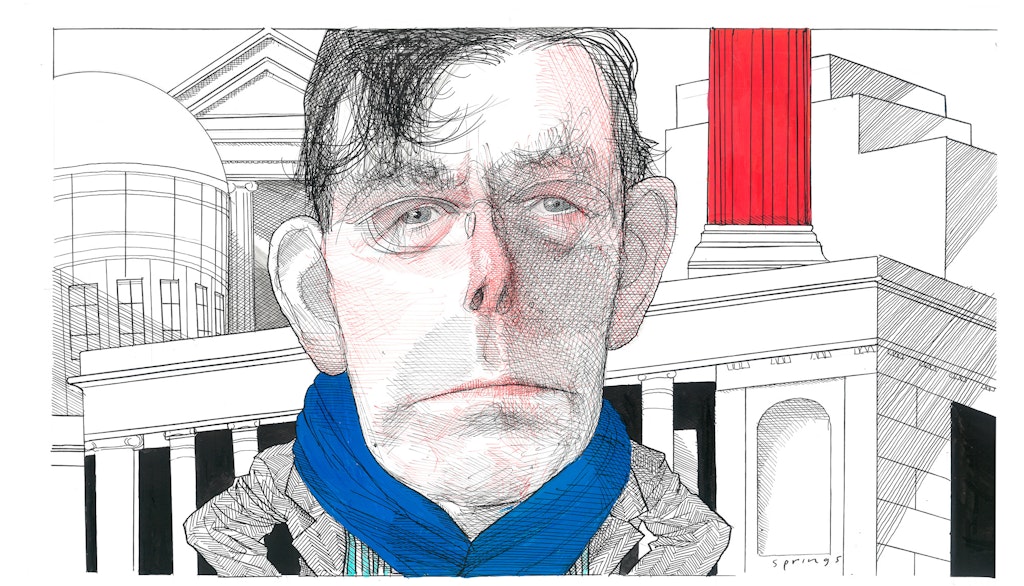A passionate battler for buildings
A manichaean choice between the organic adaptation of old buildings and the beauty of the new
This article is taken from the November 2024 issue of The Critic. To get the full magazine why not subscribe? Right now we’re offering five issues for just £10.
It was only when I read the acknowledgements of Simon Jenkins’ A Short History of British Architecture that I realised why he has devoted so much of his life to writing about architecture alongside his better known work as a commentator, journalist and, although relatively briefly, editor of the Evening Standard in the mid-1970s and of The Times in the early 1990s.

When he left Oxford in 1965, his first job as a young tyro was working for Country Life. Then, after a short spell at the Times Educational Supplement, he wrote about planning for the Evening Standard and, encouraged by John Betjeman, developed a detestation of what was happening to English towns and cities at a time when they were still being torn down to make inner city ring roads, tower blocks and multi-storey car parks. His first book, published in 1971, was City at Risk, and he became a founder member of SAVE, established in 1976.
Knowing that Jenkins started out as a 1960s conservationist helps to explain his approach to architectural history. He is at heart an architectural enthusiast, a passionate church-crawler, who reveals that as a child he was taken up into the upper regions of St Paul’s Cathedral where he was able to inspect the still surviving bomb damage, peering down into the nave “awe-struck by what seemed a torn and battered stage set” (one slightly wonders how the child of an ardent congregationalist minister had access to the parapets of war-torn St Paul’s).
As an undergraduate, he danced at Blenheim Palace, where “we all thought we should be marching in step”. He remembers the original Covent Garden offices of Country Life from his days working there and when he objected to the demolition of the City Club in Threadneedle Street, he was driven to it by Richard Seifert in his Rolls-Royce.
Much of the narrative is an efficient and lively journalistic digest of the works of Nikolaus Pevsner (Jenkins was for a time the chairman of the Buildings Book Trust, established in 1995 to support the publication of The Buildings of England) and John Summerson, a traditional-style history enlivened with references to the churches he has himself written about in his admirable England’s Thousand Best Churches (1999) or the houses he visited as chairman of the National Trust.
Not surprising, given that he is half-Welsh and has written a book on Wales, Jenkins is good on Welsh architecture, encouraging visits, for example to the hill fort of Tre’r Ceiri (“I first visited it after a trip to Peru and considered it to rank as a British Machu Picchu”) and the church of Llandanwg, “buried in the sand dunes near Harlech in Wales”.
He is also extremely knowledgeable and passionate about London. He is pleased that Wren’s plans for a more orderly layout for the city after the Fire of London were thwarted by the returning householders who demanded a rapid rebuilding on their existing sites. He regards the other town plans drawn up by John Evelyn, Robert Hooke and others as symptomatic of the way that “the architectural mind veers towards authoritarianism”.

He writes well of the development of the West End in an ad hoc way by aristocrats with an interest in real estate and does not object to the authoritarianism of the Prince Regent in encouraging Nash to pull down swathes of buildings to create Regent Street, perhaps because it had a couple of kinks in it so as not to be purely ceremonial.
About half way through, the pace picks up as one feels the approach of battle. He writes enthusiastically about the work of Lutyens and the developers of the 1920s who were so adept at servicing the democratic wants of the massed middle classes, those who attended the Ideal Home exhibition in Kensington Olympia and chose to live in houses which were Tudorbethan.
The enemy, so far as he and his generation of conservationists are concerned, are the small numbers of high-minded architects trained at the Architectural Association in the 1930s who were keen on the gospel of Le Corbusier and joined CIAM (John Betjeman and John Summerson were also members).
Although these figures had disproportionate influence on government policy after the Second World War, to a younger generation it is hard to see as entirely bad the idealism of the Hertfordshire schools overseen by William Tatton Brown and the well-intentioned Churchill Gardens designed by Philip Powell and Hidalgo Moya.
In fact, as Jenkins himself makes clear, the people who were responsible for much of the devastation of the 1950s and 1960s were the ruthless developers, aided and abetted by sometimes corrupt local government officers, doing what they thought was good for their cities but neglecting the buildings and urban fabric that had survived the war.

It is good to be reminded of some of the madder and more megalomaniac schemes of the 1960s: Leslie Martin’s plan to flatten most of Whitehall, T. Dan Smith’s demolition of so much of historic Newcastle, the ghastliness of Cumbernauld New Town and the now demolished multi-storey tower blocks in the Gorbals.
When it comes to the history of attitudes to conservation at the time, an unexpected hero emerges in Duncan Sandys, briefly Minister of Housing under Winston Churchill and responsible for founding the Civic Trust in 1957. Later, in 1967, he launched the Civic Amenities Act as a private members’ bill which established the idea of conservation areas, an important change in attitude to the historic environment. I suspect that Sandys’ desire to protect historic buildings was actually much more common than appears in the history books, which privilege the radicalism of architectural modernism.
The book ends with two chapters of pugnacious peroration in favour of the orthodoxies of conservation — the ideas of Jane Jacobs, the switch to the preservation of old buildings in the 1970s, the advent of post-modernism and the views of the Prince of Wales.
I mostly support Jenkins’ views. Like him, I don’t like the way that Battersea Power Station is now surrounded by a mass of expensive housing for international residents or that the City of London is allowing what remains of its urban fabric to be demolished for a mass of ill-considered, gigantic tower blocks. But I am more sympathetic to some of what he most dislikes. The Barbican has aged well and interestingly.
He leaves out the work of some of the good modernists, including Richard MacCormac’s work for Oxbridge, Jeremy Dixon and Edward Jones’ renovation of the Royal Opera House and Michael and Patty Hopkins’ new opera house at Glyndebourne. He ends with a manichaean choice between Borough Market — the organic adaptation of old buildings — and Renzo Piano’s Shard — the beauty of the new.
There are some occasional and surprising errors: Jenkins claims that Hampton Court was converted for William and Mary in 1685 when they only took the throne in 1688 and that the topping-out ceremony for St Paul’s was in 1723, the year of Wren’s death. More importantly, in a book about architecture up to the Shard, there could have been more about the best recent new buildings to counterbalance Jenkins’ conservationist views.
Enjoying The Critic online? It's even better in print
Try five issues of Britain’s most civilised magazine for £10
Subscribe














